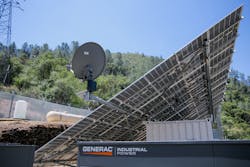Pacific Gas & Electric (PG&E) has launched a multifaceted microgrid strategy to keep power flowing to customers when conventional electrical equipment becomes a wildfire threat.
As part of its wildfire safety plan, the utility is pursuing three kinds of microgrids to help avert public safety power shutoffs (PSPS):
- Remote, off-grid facilities located at the end of wildfire prone distribution lines.
- Distribution microgrids for key resources, such as hospitals, in towns and cities.
- Substation microgrids.
Earlier this month, as part of the plan, PG&E commissioned a remote microgrid in a fire prone region outside of Yosemite National Park at the end of a long distribution line. The off-grid, hybrid Briceburg microgrid is expected to be the first of many installed to replace distribution systems in remote areas.
Hundreds of sites identified
In fact, the company’s wildfire safety plan has identified hundreds of areas where these could be deployed and has a target of installing 20 such systems by the end of 2022, said Paul Doherty, PG&E spokesman.
The remote microgrid was built and installed by BoxPower and includes solar, energy storage and backup propane generation. It will permanently replace 1.4 miles of line that was destroyed by a fire in 2019.
“This is a new approach to utility service,” said Doherty. “The whole point of the remote microgrid is to remove those power lines that run through high fire threat areas.”
The company decided to install the microgrid instead of rebuilding, hardening and maintaining the distribution line because it was more cost effective, posed a lower wildfire risk and offered equal or higher levels of reliability, he said. The microgrid will serve five customer meters, including two homes, a visitor information center, a transportation facility and a telecommunications facility.
Since the line was destroyed in 2019, PG&E has used temporary, fossil-fuel fired generators to serve customers, who have a load of about 12 kW. The new microgrid is expected to run on solar and storage 70% to 90% of the time, said Doherty.
The BoxPower SolarContainer, along with an auxiliary ground-mounted solar array, will supply 36.5 kW of PV. The microgrid also includes a 27.2 kW/68.4 kWh lithium ferro phosphate battery and two propane generators that produce 35 kW. A fire suppression system will protect the microgrid. PG&E, which owns the microgrid, is able to control it remotely.
In California’s ongoing microgrid proceeding, stakeholders are questioning whether all taxpayers should pay for microgrids that service specific numbers of people. Some argue that they serve the public good, especially if they serve hospitals or other services.
In this case, because the remote system replaces poles and wires, PG&E paid for the microgrid with money used for distribution systems, said Doherty.
Distribution microgrids for key resources
In addition to the remote, off-grid microgrids, PG&E has plans to utilize distribution microgrids, which are hubs that serve areas prone to PSPS. These distribution microgrids are designed to keep key community resources, such as gas stations and banks, operating. The company plans to install about 10 distribution microgrids in the near future.
“We have developed a road map toward clean energy for PSPS mitigation,” said Doherty. “We see it, over the next few years, as more feasible as technology develops.”
Microgrid strategy for substations
Substation improvements also play into PG&E’s microgrid strategy. “We’re working to test temporary generation at 10 substations by August 1. Most are under development and target communities that have been affected multiple times by PSPS,” he said.
Meanwhile, PG&E has reserved about 300 MW of diesel generators for substations and distribution areas. The utility has met with criticism for using diesel fuel, and the company recently held a workshop that aimed to uncover ways to reduce its use during fire emergencies and PSPS.
Separately, the company also launched a community microgrid plan. The California Public Utilities Commission in March approved the plan to help local governments and tribes install community microgrids to protect critical facilities when there are widespread power outages.
PG&E community microgrid strategy
The Community Microgrid Enablement Program is an outgrowth of the commission’s efforts to support the commercialization of microgrids, which is required by state law, SB 1339.
PG&E expects to spend up to $27 million in matching funds this year, and, in 2022, it plans to make distribution system upgrades needed to bring the community microgrids online. The program provides $9 million a year for disadvantaged and vulnerable communities. Usually, the upgrade costs are borne by the owner of the microgrid.
The Redwood Coast Airport Microgrid is one example of a community microgrid, built under a partnership that includes PG&E, the Schatz Energy Research Center and the County of Humboldt. The microgrid will be grid connected and can operate in island mode. With 2.2 MW of PV and a 2.2 MW, 8.8 MWh battery storage system, it’s scheduled to be completed by the end of the year. The microgrid will be connected to the grid and is expected to provide solar to the California Independent System Operator.
“It’s a model for how we want to deploy community microgrids,” said Doherty.
More surgical risk assessment
To also address wildfire risks, PG&E is planning a more granular approach to identifying high-risk communities.
“We can go in and figure out what are the key communities impacted by PSPS. We use risk modeling technology to prioritize these areas,” said Doherty. “This allows us to more surgically conduct PSPS and bring in mobile generation to serve those loads.” In 2020, PG&E cut by 55% the number of customers affected by PSPS using this technique, he said.
Alternative grid architectures
PG&E finds itself embracing alternative technologies in its efforts to avoid wildfires sparked by its equipment and provide resilience to its customers, according to Doherty. The Briceburg microgrid, for example, is one of the first utility-owned, stand-alone power systems deployed in the US as a permanent generation solution.
“There’s a lot going on. It’s exciting to see PG&E is embracing alternative grid architectures,” he said
Track news about PG&E’s microgrid strategy. Subscribe to the free Microgrid Knowledge Newsletter.








